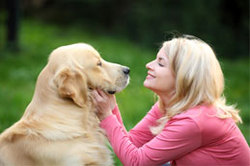Dogs are mirrors: Calm non-verbal communication can lessen behavior problems

Photo courtesy of peaceofmindforpetlovers.com
Human gets angry and verbally shouts threats at dog. Dog still does not come. Human angrily stomps after dog and drags the dog to the car where the dog is shoved into the car — with the human still shouting at the dog.
What can we learn from this vignette (other than that dogs should not be off-leash in the vet’s parking lot)? There are three key observations:
1. Verbal communication is not a dog’s primary method of communicating. We can train dogs to respond to verbal commands — but it takes a good bit of time and effort to get these verbal comments to be reliable.
2. The tone of our verbal commands — or one could say our “energy” when we give the verbal commands — says more to the dog that the words which we use.
3. Our non-verbal behavior — how we stand, how we breathe, our muscle tension, all part of our “energy” — says the most to our dog.
We humans primarily communicate verbally. Dogs are different. In the wild, one dog does not “say” to another … “Come on over here so I can show you something.” Dogs communicate primarily through body language and “energy”.
Try this little experiment with your dog. Get your dog’s attention. Do not call it’s name. (Stand close enough to your dog to make this work). Snap your fingers, or make a slight sound with your voice or clap your hands. Now your dog is looking at you. Bend down and give a big grin. Does your dog come to you?
Now try this experiment. Make sure your dog is NOT looking at you. The dog should be in the same room but distracted by something else. Now yell at the dog angrily. After you have shouted and yelled a few times stop the experiment. You have successfully taught your dog not to come to you.
Truly, what dog wants to come when a punishment is sure to follow? What is important is the tone of voice used to call the dog. As with our earlier experiment we found our dog happy and eager to come when our tone of voice and body language reflect how happy and pleased we are with our dog.
Remember when dogs interact with each other, when a dog will happily play with another dog, friendly body language is used. The dog bows down to another dog — the dog circles and sniffs another dog. The dog runs and the other dog follows. But if a dog wants to play it does not act menacing toward another dog. They don’t show their teeth and lunge forward when seeing another dog.
Why? Dogs in the wild do not want aggression. The dogs instinctively know that when a fight begins, one dog is going to be seriously harmed. Dogs will try other tactics before they actually fight.
How does this reflect on us when we are interacting with our dogs? Dogs mirror us. Whether we are at one end of the leash or across the room, through our body posture and our unspoken language we convey fear, excitement, or anxiety. Survival is hardwired into a dog’s genes. When we, as their pack leaders, demonstrate fear, they mirror it.
As Caesar Milan often says: “When a naturally submissive dog lives with a human that does not lead, he or she will attempt to right the pack balance by filling what they see as a vacant pack leader role. This is how behavior problems develop. To establish yourself as pack leader, you must always project a calm, assertive energy. This natural balance calm, assertive leadership with calm submissive behavior nurtures stability and creates a balanced, centered, and happy dog.”
Try a little experimenting. I would be interested to learn what you find.
Julia Levitt is the founder of In Harmony Dog Training (www.inharmonydogtraining.com) in Ann Arbor. She can be reached at julia@inharmonydogtraining.com or at 734-645-4707. Julia provides individual training for dogs and their owners, and also conducts dog training classes at Ann Arbor Animal Hospital.


Comments
Julia Levitt
Thu, Mar 7, 2013 : 2:39 a.m.
JNS- You have a good sense of humor! Julia
jns131
Wed, Mar 6, 2013 : 2:28 a.m.
Uh, I think we also need to realize one thing. Who adopted who? Who rescued who? I find our dogs seem to think that they command us. You have not seen a Chihuahua when the animal is in distress. What a noise they make. They act like someone who is really upset. Great article but I still say this. It is the dog who is in control. Not you. On leash or not. This foes for cats too. Although Garfield and Odie do have their takes on this one.
Elaine F. Owsley
Tue, Mar 5, 2013 : 12:54 p.m.
I have found most of our dogs respond to that noise you can make with your tongue and teeth that is a little like "csk csk" kind of like that used to get horses to gittyyup". They will come or hurry. The negative sound "unh unh" if said firmly will often get their attention away from whatever unacceptable behavior is going on. (That last one worked with the kids, too.)
Julia Levitt
Tue, Mar 5, 2013 : 3:50 p.m.
Hi elaine- i am not a "kid whisperer" but you have a very helpful comment for those that are! julia
KathrynHahn
Tue, Mar 5, 2013 : 11:55 a.m.
On a side note, dogs short term memory is around 10 minutes, so don't yell at them for something you "find" that may have been done overnight, they may think they're being yelled at for what they are currently doing!